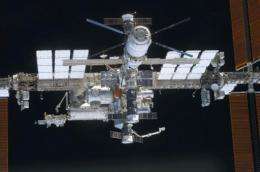Debris narrowly misses International Space Station (Update 2)

A piece of space debris narrowly missed the International Space Station on Tuesday in a rare incident that forced the six-member crew to scramble to their rescue craft, space agency officials said.
The high-speed object hurtled toward the orbiting lab and likely missed it by just 1,100 feet (335 meters). The crew moved to shelter inside two Soyuz spacecraft 18 minutes before the debris was expected to pass, NASA said.
Space debris a growing problem
"It was probably the closest object that has actually come by the space station," said the US space agency's associate administrator for space operations, Bill Gerstenmaier. "We didn't have any information that it was coming until it was very, very close."
The size of the space junk remains unknown and no harm was done by its fly-by.
The six astronauts climbed into the Soyuz craft at 7:50 am Eastern time (1150 GMT), and the expected time of closest approach to the object was 8:08," said NASA spokeswoman Stephanie Schierholz.
They spent about half an hour in the Russian space capsules and then went "back to their regular day," she added.
The event was unusual but not unheard of. A similar event on March 12, 2009 forced the crew of the space station to seek temporary shelter when a piece of space debris approached.
"We monitor space debris pretty closely so this is not, sort of, out of the realm of what we know can happen," Schierholz said.
"But obviously, we are concerned about the safety of the crew so that is why we had them take shelter."
Space experts say such events are only becoming more frequent as the amount of waste -- from nuts and bolts to rocket parts -- is on the rise due to everything from basic wear and tear to controversial military testing.
Millions of chunks of metal, plastic and glass are whirling round Earth, the garbage left from 4,600 launches in 54 years of space exploration.
The collision risk is low, but the junk travels at such high speed that even a tiny shard can cripple a satellite costing tens of millions of dollars.
Around 16,000 objects bigger than four inches (10 centimeters) across are tracked by the US Space Surveillance Network, according to NASA.
The space station has never been hit by major space debris as it orbits some 220 miles (350 kilometers) above Earth, and officials from all nations involved are taking extra precautions to make sure that the orbit being taken up by the ISS remains clean, analysts said.
"The orbit used by the ISS is no longer being littered," Moscow's Space News magazine editor Igor Marinin told AFP's bureau in the Russian capital.
"The incidents we might see in the future could be extreme but they will not be fatal."
The first module of the 16-nation ISS program was launched by Russia in 1998. The station has been built up over the years with the help of the US space shuttle program, which ends later this year after Atlantis's final mission on July 8.
Russia is a vocal critic of tests being conducted by nations like China, in which outdated satellites are blasted by new missile systems, creating spectacular explosions that can have a profound impact on outer space.
Four known collisions have occurred between tracked objects, according to France's National Center for Space Studies (CNES).
In 1991, the Russian navigation satellite Cosmos 1991 collided with debris from a defunct Russian satellite, Cosmos 926, although this event only came to light in 2005.
A fragment from an exploded Ariane rocket launched in 1986 damaged a French spy micro-satellite, Cerise, 10 years later.
In 2005, the upper stage of a US Thor launcher hit debris from a Chinese CZ-4 rocket.
And in 2009, a disused Russian military satellite, Cosmos 2251, smacked into a US Iridium communications satellite, generating a debris cloud in its own right.
In low Earth orbit, which is where the ISS is deployed, debris impacts at around six miles (10 kilometers) per second (22,400 miles per hour or 36,000 kilometers per hour), said the CNES.
The ISS is currently manned by three Russians, two Americans and a Japanese astronaut.
The commander of the current mission to the ISS, Expedition 28, is Andrey Borisenko. The flight engineers are Alexander Samokutyaev, Mike Fossum, Satoshi Furukawa, Ron Garan and Sergei Volkov.
The Soyuz TMA-20 undocked at the orbiting lab on May 23 and the three newest crew members arrived June 9 on the Soyuz TMA-02M. The crew usually stays for six-month stretches aboard the space station.
(c) 2011 AFP



















